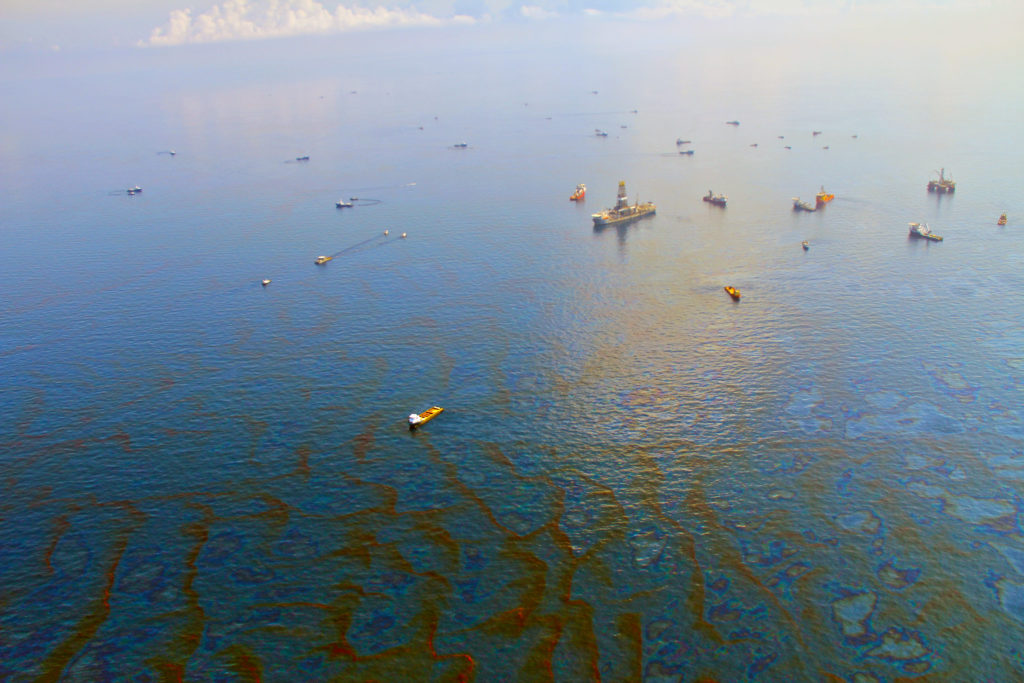Bioremediation: A Pollution Solution
By Dr Catriona Nguyen-Robertson MRSV
Senior Editor, Science Victoria
Our environment is being constantly bombarded by pollutants. They are found in the deepest oceans, high in the atmosphere, throughout urban areas, and in the most remote locations on Earth. Once pollutants enter the environment, they are carried across vast distances. Pollution is a global problem.

Our polluted planet
Earlier industrialisation and poor environmental management have left a legacy of contamination. Over three million sites around the globe are classified as contaminated (over 2.8 million estimated in the EU alone)1 – and this number is a significant underestimate. Because the environmental and health hazards associated with contaminated sites vary so widely, they can be difficult to recognise – especially when the functions of the former industrial site halted long ago.
To make matters more difficult, pollutants are becoming increasingly complex as humans develop new compounds that can leach into the environment. Most of these sites therefore remain untreated.
For centuries, most people regarded the environment as resilient, and that “little spills” of chemicals here and there would not cause great harm. The 1989 Exxon Valdez oil spill was a turning point: 11 million gallons of crude oil spilled from an oil tanker, impacting over 2000 km of Alaskan coastline.2 It was the largest offshore oil spill ever recorded in the USA, until the Deepwater Horizon oil spill in 2010 dumped 134 million gallons of oil into the Gulf of Mexico.3
Clean-up on aisle… everywhere
With these massive offshore oil spills in addition to the constant waste generated by agricultural farms, textile factories, and even households, it became clear that the environment cannot simply bounce back from our level of waste.
The typical approach of dealing with environmental waste was often to sweep it under the carpet – to literally bury it. While a cheap solution, it is unsustainable, especially as chemicals inevitably eventually leach into the surrounding environment. Heating contaminated soil to high temperatures in a process referred to as ‘thermal desorption’ can also remove contaminants, but it is very expensive, and renders the soil useless. Therefore, a more viable method of removing environmental contaminants is called for.
Biological remedies for contaminated localities
Professor Andy Ball and his team at RMIT are working on solutions to environmental pollution at different sites around the world, primarily through the process of ‘bioremediation’. Bioremediation is the process of using biological organisms or systems – most often bacteria, microalgae, fungi, and/or plants – to remove pollutants from an environment.4 These organisms break down the contaminants into non-harmful products, with the benefit of working 24/7 for free.
An estimated 9.2×1029 – 31.7×1029 (92 and 317 with 28 zeros after it) bacteria live on the planet.5 Over billions of years, they have evolved to use everything at their disposal on Earth as nutrients to survive and thrive.
Fortunately for us, this includes our waste.
One third of current bioremediation projects target petroleum waste. With microbes having lived side-by-side with crude oil for so long as they formed over millions of years, we have been able to identify and harness bacteria that consume it. Part of the reason that crude oil can be difficult to clean up from the environment is that it is not homogenous – it is a mix of chemicals. Some bacterial species can use carbon from crude oil as a fuel source of their own, and convert toxic pollutants into harmless products like water and carbon dioxide. It is a matter of identifying which ones can help.
Bioremediation case studies
The work of Prof Ball and his team often begins in the lab. They identify microbes that can break down specific types of waste, along with the nutrients that help them do so faster, and then move into the field.
Professor Ball’s research team, led by Dr Claire Bird, did precisely this, starting by growing microorganisms in a flask with a small amount of waste oil. By the end of the project, the team was spraying a mixture of those microbes and all the nutrients they needed onto diesel-contaminated soil. From those humble beginnings in a lab, 1000 m3 of contaminated soil eventually became clean enough for use in gardens.6
At a petroleum facility on Jurong Island in Singapore, another of Professor Ball’s former students, Dr Greg Poi, has implemented a large-scale bioremediation project. Ground water at the site was contaminated with petroleum compounds (collectively known as ‘total petroleum hydrocarbons’). By incubating a cocktail of microbes with the contaminated ground water in a tank, and providing a fresh supply of microbes every month, Dr Poi and Professor Ball created a consortium of 22 microorganisms that successfully treated 200,000 L of water.7
Dr Poi has since transferred his bioremediation success to contaminated soil, worked as an industry consultant to oil corporations such as Exxon-Mobil, Shell and Vopax, and established his own bioremediation company in Singapore
Ever-evolving solutions for an ever-changing problem
Given the scale of the pollution problem, Professor Ball believes that it is important to commercialise and translate the findings of his team’s laboratory research for use in the field. But the basic research never stops, especially given that new and increasingly complex compounds are being produced and released into the environment.
As an example, chlorinated compounds have become ubiquitous in the environment, and are difficult to treat. Chloroethenes, used in dry cleaning and degreasing agents, are now common in groundwater and are extremely harmful to humans and the environment due to their carcinogenic properties.
Over ten years ago, a group of bacteria (Dehalococcoides) were found to be able to remove the damaging chlorine groups from chloroethene in the environment. While these bacteria species are commercially available to buy and add to groundwater, Professor Ball has decided not to use them in Australia, as they might not be indigenous to the environment. He did not want to be creating a different problem by adding bacteria to the environment that didn’t belong. Instead, he focused on existing microbial communities rather than relying on a single species, and managed to manipulate existing microbe communities in ground water sampling sites across Victoria to do the same thing.8
Chlorophyll-tration
Plants can also be used for bioremediation, cleaning up hazardous contaminants in soil, air, and water through a process called phytoremediation. The process takes advantage of the ability of certain plants, known as hyperaccumulators, to accumulate and concentrate certain elements and compounds from the environment. Hyperaccumulator plants extract metal compounds from deep in the soil and transport them into the stem, leaves and flower. Not only does this process help to clean the environment, the accumulated metals are essentially being “farmed” and can be repurposed.

The sunflower plant (Helianthus annuus), for example, can take up heavy metal pollutants such as arsenic, nickel, zinc, cadmium and lead from soil, and is often used to clean up environmental contamination.9 Sunflowers are also particularly adept at extracting radioactive metals, like the radioactive caesium and strontium isotopes found in Chernobyl and Fukushima after the Chernobyl Nuclear Power Plant disaster of 1986 and Fukushima explosion of 2013 respectively. Fields of sunflowers were planted to soak up these radioactive metals from the ground and were then harvested and safely disposed of.
Waste plant matter, such as mouldy straw, can also be repurposed for bioremediation, as they are full of plant-associated bacteria and fungi that can also break down pollutants. While there is success for removing some contaminants by plants alone with bioremediation, the use of plants in conjunction with plant-associated organisms offers great potential for the hydrocarbons found in coal, crude oil, and gasoline.10
Mopping up the mess we’ve made
Given that it is anthropogenic activity that pollutes the environment, it is only fitting that we turn to natural solutions to help restore it to health.
Professor Ball’s research is focused on the sustainable remediation of contaminated environments, applying cutting edge tools to reduce environmental pollution in urban environments. As we continue to pollute the environment with emerging microplastics, pharmacological products, and other chemicals, we need new solutions for these newer pollutants. Synthetic biology (e.g., improving naturally-occurring enzymes – essentially a human collaboration with nature) might be the answer, and Professor Ball is excited to see how the field evolves.
‘We are still polluting our environment – day in and day out – with new, emerging pollutants. Every individual needs to reflect on the waste they are contributing and minimise their footprint,’ says Professor Ball.
The consequences of pollution go far, but with people like Professor Ball on the case, we might be able to clean up our act – literally.
This article follows a presentation to the RSV titled “Bioremediation: Restoring Contaminated Ecosystems, Naturally”, delivered by Professor Andy Ball (RMIT University), awardee of the 2021 RSV Medal for Excellence in Scientific Research. His work ensures that we become “better custodians of our environment,” as The Hon. Lily D’Ambrosio MP noted when presenting him with the award.
You can watch Professor Ball’s presentation at youtu.be/8ZoBy_ewLvc.
References:
- European Environment Agency. (2024, April 16). Progress in the management of contaminated sites (Indicator). European zero pollution dashboards. eea.europa.eu/en/european-zero-pollution-dashboards/indicators/progress-in-the-management-of-contaminated-sites
- NOAA. (2020, August 17). Exxon Valdez | Oil Spills | Damage Assessment, Remediation, and Restoration Program. NOAA. darrp.noaa.gov/oil-spills/exxon-valdez
- NOAA. (2022, October 5). Deepwater Horizon | NOAA’s Damage Assessment Remediation and Restoration Program. NOAA. darrp.noaa.gov/oil-spills/deepwater-horizon
- Industrial Biotechnology, (overview). P. Vaishnav, A.L. Demain, in Encyclopedia of Microbiology (Third Edition), 2009 sciencedirect.com/referencework/9780123739445/encyclopedia-of-microbiology
- Kallmeyer, J., et al. (2012). Global distribution of microbial abundance and biomass in subseafloor sediment. Proceedings of the National Academy of Sciences, 109(40), 16213–16216. https://doi.org/10.1073/pnas.1203849109
- Adetutu, E. M., et al. (2014). Exploiting the intrinsic hydrocarbon-degrading microbial capacities in oil tank bottom sludge and waste soil for sludge bioremediation. International Journal of Environmental Science and Technology, 12(4), 1427–1436. https://doi.org/10.1007/s13762-014-0534-y
- Poi, G., et al. (2017). Bioremediation of Phenol-Contaminated Industrial Wastewater Using a Bacterial Consortium—from Laboratory to Field. Water, Air, & Soil Pollution, 228(3). https://doi.org/10.1007/s11270-017-3273-0
- Patil, S. S., et al. (2013). Biostimulation of indigenous communities for the successful dechlorination of tetrachloroethene (perchloroethylene)-contaminated groundwater. Biotechnology Letters, 36(1), 75–83. https://doi.org/10.1007/s10529-013-1369-1
- Alaboudi, K. A., et al. (2018). Phytoremediation of Pb and Cd contaminated soils by using sunflower (Helianthus annuus) plant. Annals of Agricultural Sciences, 63(1), 123–127. https://doi.org/10.1016/j.aoas.2018.05.007
- Shukla, K., P., et al. (2013). Rhizoremediation: A Promising Rhizosphere Technology. In Patil, Y., B. & Rao, P. (Eds), Applied Bioremediation – Active and Passive Approaches https://doi.org/10.5772/56905






